1000+ Cell - the unit of life MCQ for SSC Scientific Assistant [Solved]
Thursday 9th of March 2023

Sharing is caring
1. In the given figure of animal cell, one orginelle is marked as A. Select the correct identification and function of the organelle A from the given option.
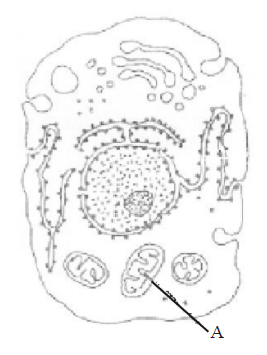
A. Endoplasmic reticulum Synthesis of lipids.
B. Mitochondria Produce cellular energy in the form of ATP.
C. Golgi body Provides packaging material.
D. Lysosomes Secrete hydrolytic enzymes.
Answer : B

A. Endoplasmic reticulum Synthesis of lipids.
B. Mitochondria Produce cellular energy in the form of ATP.
C. Golgi body Provides packaging material.
D. Lysosomes Secrete hydrolytic enzymes.
Answer : B
2. Most of water, in mature plant cells occurs in
A. nucleus
B. cell wall
C. vacuoles
D. cytoplasm
Answer : C
A. nucleus
B. cell wall
C. vacuoles
D. cytoplasm
Answer : C
3. You are asked to examine a cell using a powerful light microscope. The image you see has a clearly defined nucleus and mitochondria. It also has a large central vacuole and chloroplasts. From what group of organisms did this cell most likely come?
A. Bacteria
B. Protists
C. Fungi
D. Plants
Answer : D
A. Bacteria
B. Protists
C. Fungi
D. Plants
Answer : D
4. Active transport across biomembrane involves
A. production of ATP
B. requirement of energy
C. production of toxin
D. release of energy
Answer : B
A. production of ATP
B. requirement of energy
C. production of toxin
D. release of energy
Answer : B
5. Both the membranes of mitochondrion are
A. structurally different but functionally similar.
B. structurally as well as functionally different.
C. structurally similar but functionally different.
D. structurally different but functionally similar.
Answer : B
A. structurally different but functionally similar.
B. structurally as well as functionally different.
C. structurally similar but functionally different.
D. structurally different but functionally similar.
Answer : B
6. Which of the following pair are correctly matched.
A. Microtubules Structural components of cilia
B. Centrioles Store hydrolytic enzymes
C. Amyloplasts Store oil protein and starch in plants
A. A, B and C
B. A and B
C. A
D. A and C
Answer : C
A. Microtubules Structural components of cilia
B. Centrioles Store hydrolytic enzymes
C. Amyloplasts Store oil protein and starch in plants
A. A, B and C
B. A and B
C. A
D. A and C
Answer : C
7. The best material for study of structure of cell membrane is
A. RBC of human
B. RBC of frog
C. cheek cell of human
D. liver cell of rat
Answer : A
A. RBC of human
B. RBC of frog
C. cheek cell of human
D. liver cell of rat
Answer : A
8. The following diagram shows some of the missing structures in a plant cell marked as A, B, C, D E. Choose the option with their correct names.
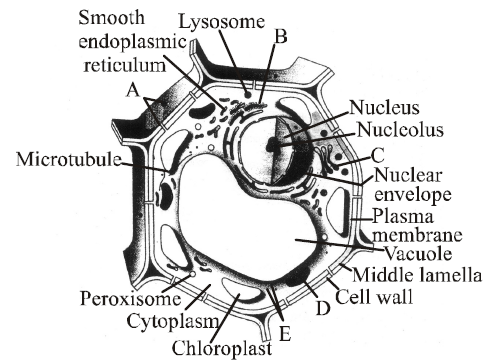
A. A - Plasmodesmata, B - Rough endoplasmic reticulum, C - Golgi apparatus, D - Mitochondrion, E - Ribosomes
B. A - Desmosome, B - Rough endoplasmic reticulum, C - Golgi apparatus, D - Mitochondrion, E - Ribosomes
C. A - Plasmodesmata, B - Smooth endoplasmic reticulum, C - Golgi apparatus, D - Mitochondrion, E - Ribosomes
D. A - Tight junction, B - Rough endoplasmic reticulum, C - Golgi apparatus, D - Mitochondrion, E -Ribosomes
Answer : A

A. A - Plasmodesmata, B - Rough endoplasmic reticulum, C - Golgi apparatus, D - Mitochondrion, E - Ribosomes
B. A - Desmosome, B - Rough endoplasmic reticulum, C - Golgi apparatus, D - Mitochondrion, E - Ribosomes
C. A - Plasmodesmata, B - Smooth endoplasmic reticulum, C - Golgi apparatus, D - Mitochondrion, E - Ribosomes
D. A - Tight junction, B - Rough endoplasmic reticulum, C - Golgi apparatus, D - Mitochondrion, E -Ribosomes
Answer : A
9. Identify the components labelled A, B, C and D in the given section of cilia/flagella showing different parts. Choose the option which shows the correct labelling of parts.
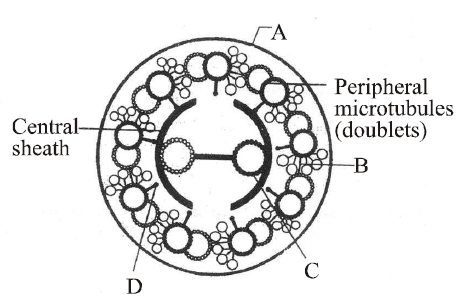
A. A Plasma membrane, B Interdoublet bridge, C Central microtubule, D Radial spoke
B. A Plasma membrane, B Arm, C Central microtubule, D Radial spoke
C. A Plasma membrane, B Interdoublet bridge, C Hub, D Radial spoke
D. A Plasma membrane, B Interdoublet bridge, C Hub, D Arm
Answer : A

A. A Plasma membrane, B Interdoublet bridge, C Central microtubule, D Radial spoke
B. A Plasma membrane, B Arm, C Central microtubule, D Radial spoke
C. A Plasma membrane, B Interdoublet bridge, C Hub, D Radial spoke
D. A Plasma membrane, B Interdoublet bridge, C Hub, D Arm
Answer : A
10. The given diagram shows the types of chromosomes (labelled as A, B, C & D) based on the position of centromere.
Which one is the correct option for the labelled chromosomes. A, B, C and D ?

A. A Telocentric chromosome, B Acrocentric chromosome, C Submetacentric chromosome, D Metacentric chromosome
B. A Acrocentric chromosome, B Telocentric chromosome, C Metacentric chromosome, D Submetacentric chromosome
C. A Submetacentric chromosome, B Metacentric chromosome, C Telocentric chromosome, D Acrocentric chromosome
D. A Metacentric chromosome, B Submetacentric chromosome, C Acrocentric chromosome, D Telocentric chromosome.
Answer : A
Which one is the correct option for the labelled chromosomes. A, B, C and D ?

A. A Telocentric chromosome, B Acrocentric chromosome, C Submetacentric chromosome, D Metacentric chromosome
B. A Acrocentric chromosome, B Telocentric chromosome, C Metacentric chromosome, D Submetacentric chromosome
C. A Submetacentric chromosome, B Metacentric chromosome, C Telocentric chromosome, D Acrocentric chromosome
D. A Metacentric chromosome, B Submetacentric chromosome, C Acrocentric chromosome, D Telocentric chromosome.
Answer : A
11. Which of the following lacks cell wall?
A. Gametes
B. Amoeba
C. Mycoplasma
D. All of these
Answer : D
A. Gametes
B. Amoeba
C. Mycoplasma
D. All of these
Answer : D
12. Grana are
A. protein storing plastids.
B. coloured plastids.
C. stacks of thylakoids.
D. individual thylakoids present in stroma.
Answer : C
A. protein storing plastids.
B. coloured plastids.
C. stacks of thylakoids.
D. individual thylakoids present in stroma.
Answer : C
13. Lysosomes contain
A. carbohydrates
B. hormones
C. nucleic acids
D. hydrolases.
Answer : D
A. carbohydrates
B. hormones
C. nucleic acids
D. hydrolases.
Answer : D
14. Which of the following pair lack the unit membrane?
A. Nucleus and E.R.
B. Mitochondria and chloroplast
C. Ribosome and nucleolus
D. Golgi body and lysosome
Answer : C
A. Nucleus and E.R.
B. Mitochondria and chloroplast
C. Ribosome and nucleolus
D. Golgi body and lysosome
Answer : C
15. _______________ is the important site of formation of glycoproteins and golycolipids.
A. SER
B. Lysosome
C. Golgi apparatus
D. Mitochondria
Answer : C
A. SER
B. Lysosome
C. Golgi apparatus
D. Mitochondria
Answer : C
16. Choose the wrong statements regarding bacterial cell
A. (i) and (iii)
B. (i) and (ii)
C. (ii) and (iii)
D. (i) and (iv)
Answer : C
- Glycocalyx is the outermost envelope in bacteria.
- The glycocalyx could be a loose sheath called capsule.
- The glycocalyx may be thick and tough called slime layer.
- A special structure formed by the plasma membrane is called mesosome.
- Small bristle like fibres sprouting out of the cell are called fimbriae.
A. (i) and (iii)
B. (i) and (ii)
C. (ii) and (iii)
D. (i) and (iv)
Answer : C
17. Match column-I and column-II and select the correct answer
A. A III; B IV; C II; D I
B. A II; B IV; C III; D I
C. A I; B II; C III; D IV
D. A IV; B III; C I ; D II
Answer : B
| Column-I | Column-II |
|---|---|
| A. Bacteria without walls | I. Lysosome |
| B. Small circular DNA | II. Mycoplasma cells |
| C. Flattened sacs in | III. Thylakoid a chloroplast |
| D. A vesicle in which | IV. Plasmid hydrolytic enzymes are stored |
A. A III; B IV; C II; D I
B. A II; B IV; C III; D I
C. A I; B II; C III; D IV
D. A IV; B III; C I ; D II
Answer : B
18. Select the incorrect statement about prokaryotic ribosomes.
A. 50S and 30S subunits unite to form 70S ribosomes.
B. Polysome/polyribosome consists of many ribosomes only.
C. Ribosome is the site of protein synthesis.
D. Polysome indicate the synthesis of identical poolypeptide in multiple copies.
Answer : B
A. 50S and 30S subunits unite to form 70S ribosomes.
B. Polysome/polyribosome consists of many ribosomes only.
C. Ribosome is the site of protein synthesis.
D. Polysome indicate the synthesis of identical poolypeptide in multiple copies.
Answer : B
19. Which of these is wrongly matched?
A. Chloroplasts Chlorophyll
B. Elaioplasts Starch
C. Chromoplasts Carotenoids
D. Amyloplasts Carbohydrates
Answer : B
A. Chloroplasts Chlorophyll
B. Elaioplasts Starch
C. Chromoplasts Carotenoids
D. Amyloplasts Carbohydrates
Answer : B
20. Which one of the following combination is mismatched?
A. Glycocalyx May be capsule or slime layer
B. Pili Reproduction
C. Cell wall Protective, determines shape, prevents from bursting
D. Flagella, pili and fimbriae Surface structures of bacterial cell
Answer : B
A. Glycocalyx May be capsule or slime layer
B. Pili Reproduction
C. Cell wall Protective, determines shape, prevents from bursting
D. Flagella, pili and fimbriae Surface structures of bacterial cell
Answer : B
21. Plastids are found in
A. all animal cells.
B. some animal cells.
C. all plant cells.
D. all plant cells and euglenoides.
Answer : D
A. all animal cells.
B. some animal cells.
C. all plant cells.
D. all plant cells and euglenoides.
Answer : D
22. 8.A student was given cell samples (A and B) to identify parts which are highlighted. He observed the samples under the microscope and list down the function of the part of cell sample. The information collected by the student is listed in the table below, on the basis of which the student infers that the samples contain the organelles.
Identify the part highlighted in the sample A and B and explain why they were called as semi-autonomous organelles?
A. Sample A - Mitochondria, Sample B - Chloroplast; because both the organelles are double membrane bound structure.
B. Sample A- Mitochondria, Sample B - Chloroplast; because they both are capable of synthesis of their own proteins only.
C. Sample A - Mitochondria, Sample B - Chloroplast; because they are capable of synthesis of their own proteins and contain their own DNA.
D. Sample A- Mitochondria, Sample B - Chloroplast; because they contain their own DNA to transfer the genetic information from one generation to another.
Answer : C
| Sample A | Sample B |
|---|---|
| Make energy available for cellular metabolism | Generates ATP and synthes izes s ugar |
| Absent in cell that carry oxygen throughout the body | Present in plant cell |
| Called the energy currency of cell | Source o f all the food energy |
Identify the part highlighted in the sample A and B and explain why they were called as semi-autonomous organelles?
A. Sample A - Mitochondria, Sample B - Chloroplast; because both the organelles are double membrane bound structure.
B. Sample A- Mitochondria, Sample B - Chloroplast; because they both are capable of synthesis of their own proteins only.
C. Sample A - Mitochondria, Sample B - Chloroplast; because they are capable of synthesis of their own proteins and contain their own DNA.
D. Sample A- Mitochondria, Sample B - Chloroplast; because they contain their own DNA to transfer the genetic information from one generation to another.
Answer : C
23. The best way to identify a cell as either prokaryotic or eukaryotic is to determine whether
A. it came from a single-celled or multicellular organism.
B. it has a nucleus.
C. it has a plasma membrane.
D. it has cytosol.
Answer : A
A. it came from a single-celled or multicellular organism.
B. it has a nucleus.
C. it has a plasma membrane.
D. it has cytosol.
Answer : A
24. 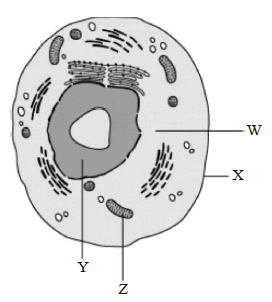
Which cellular structure helps in transferring genetic information from one generation to another?
A. W
B. X
C. Y
D. Z
Answer : C

Which cellular structure helps in transferring genetic information from one generation to another?
A. W
B. X
C. Y
D. Z
Answer : C
25. Given below are some characters of a cell organelle identify the correct organelle which shows all the characters described above.
A. Golgi apparatus
B. Lysosomes
C. Endoplasmic reticulum
D. Vacuoles
Answer : D
- It is a membrane bound space found in the cytoplasm.
- It is bound by a single membrane called tonoplast.
- It contains water, sap, excretory products and other materials not useful to the cell.
- It has higher concentration of sap than the cytoplasm.
A. Golgi apparatus
B. Lysosomes
C. Endoplasmic reticulum
D. Vacuoles
Answer : D
26. Which of the following statements are incorrect ?
A. (i) and (iii)
B. (iii) and (iv)
C. (ii) and (iv)
D. (i) and (iv)
Answer : A
- Plant cells have centrioles which are absent in almost all animal cells.
- Ribosomes are the site of protein synthesis.
- The middle lamella is a layer mainly of calcium carbonate which holds the different neighbouring cells together.
- In animal cell, steroidal hormones are synthesized by smooth endoplasmic reticulum. Of the above statements
A. (i) and (iii)
B. (iii) and (iv)
C. (ii) and (iv)
D. (i) and (iv)
Answer : A
27. Difference between the prokaryotic and eukaryotic cells in having
A. cell wall
B. nuclear membrane
C. ribosome
D. none of these
Answer : B
A. cell wall
B. nuclear membrane
C. ribosome
D. none of these
Answer : B
28. Cell sap is a
A. living content of cytoplasm.
B. nonliving content of cytoplasm.
C. nonliving content of vacuole.
D. living content of vacuole.
Answer : C
A. living content of cytoplasm.
B. nonliving content of cytoplasm.
C. nonliving content of vacuole.
D. living content of vacuole.
Answer : C
29. The given diagram shows the sectional view of a mitochondrion.

Identify the parts labelled as A, B, C, D & E
A. A - Outer membrane, B - Inner membrane, C - Matrix, D - Inter- membrane space, E - Crista
B. A - Outer membrane, B - Inner membrane, C - Intermembrane space, D - Matrix, E - Crista
C. A - Outer membrane, B - Inner membrane, C - Matrix, D - Crista, E - Inter - membrane space
D. A - Outer membrane, B - Inner membrane, C- Crista, D - Matrix, E - Inter-membrane space
Answer : A

Identify the parts labelled as A, B, C, D & E
A. A - Outer membrane, B - Inner membrane, C - Matrix, D - Inter- membrane space, E - Crista
B. A - Outer membrane, B - Inner membrane, C - Intermembrane space, D - Matrix, E - Crista
C. A - Outer membrane, B - Inner membrane, C - Matrix, D - Crista, E - Inter - membrane space
D. A - Outer membrane, B - Inner membrane, C- Crista, D - Matrix, E - Inter-membrane space
Answer : A
30. Which one of the following structures between two adjacent cells is an effective transport pathway?
A. Plasmodesmata
B. Plastoquinones
C. Endoplasmic reticulum
D. Plasmalemma
Answer : A
A. Plasmodesmata
B. Plastoquinones
C. Endoplasmic reticulum
D. Plasmalemma
Answer : A
31. Golgi apparatus is absent in
A. higher plants
B. yeast
C. bacteria and blue-green algae
D. None of the bove
Answer : C
A. higher plants
B. yeast
C. bacteria and blue-green algae
D. None of the bove
Answer : C
32. Which of the following organelles is directly connected to the outer membrane of the nucleus in a eukaryotic cell?
A. Mitochondrion
B. Lysosome
C. Golgi apparatus
D. Endoplasmic reticulum
Answer : D
A. Mitochondrion
B. Lysosome
C. Golgi apparatus
D. Endoplasmic reticulum
Answer : D
33. The fluidity of membranes in a plant in cold weather may be maintained by
A. increasing the number of phospholipids with unsaturated hydrocarbon tails.
B. increasing the proportion of integral proteins.
C. increasing concentration of cholesterol in membrane.
D. increasing the number of phospholipids with saturated hydrocarbon tail.
Answer : A
A. increasing the number of phospholipids with unsaturated hydrocarbon tails.
B. increasing the proportion of integral proteins.
C. increasing concentration of cholesterol in membrane.
D. increasing the number of phospholipids with saturated hydrocarbon tail.
Answer : A
34. A component of cytoskeleton is
A. microtubule
B. bone
C. chitin
D. cartilage.
Answer : A
A. microtubule
B. bone
C. chitin
D. cartilage.
Answer : A
35. Which of the following option correctly match A, B, C, and D indicated in the given sectional view of chloroplasts.

A. A - Thylakoid, B-Stromal lamella, C - Stroma, D - Granum
B. A - Granum, B - Thylakoid, C - Stromal lamella, D - Stroma
C. A - Thylakoid, B - Granum, C - Stromal lamella, D - Stroma
D. A - Granum, B - Thylakoid, C - Stroma, D - Stromal lamella
Answer : B

A. A - Thylakoid, B-Stromal lamella, C - Stroma, D - Granum
B. A - Granum, B - Thylakoid, C - Stromal lamella, D - Stroma
C. A - Thylakoid, B - Granum, C - Stromal lamella, D - Stroma
D. A - Granum, B - Thylakoid, C - Stroma, D - Stromal lamella
Answer : B
36. Which of the following statements is/are correct ?
A. (i), (ii), (iii) and (iv)
B. Only (i) and (ii)
C. Only (iv)
D. None of the above
Answer : A
- The shape of the cells may vary with the function they perform.
- Human RBC is about 7.0 ??m in diameter.
- Cytoplasm is the main area of cellular activities.
- Various chemical reactions occur in cytoplasm to keep the cell in the living state.
A. (i), (ii), (iii) and (iv)
B. Only (i) and (ii)
C. Only (iv)
D. None of the above
Answer : A
37. Match column-I with column-II and select the correct option.
A. A III, B II, C IV, D I
B. A II, B III, C IV, D I
C. A I, B III, C II, D IV
D. A IV, B II, C III, D I
Answer : A
| Column - I | Column - II |
|---|---|
| A. RER | I. Intracellular and extracellular digestion |
| B. Cell wall | II. Provide structural support to the cell |
| C. Flagella | III. Protein synthesis and secretion |
| D. Lysosomes | IV Responsible for cell movement |
A. A III, B II, C IV, D I
B. A II, B III, C IV, D I
C. A I, B III, C II, D IV
D. A IV, B II, C III, D I
Answer : A
38. Integral proteins of cell membrane occur on/in
A. inner surfaces
B. outer surfaces
C. phospholipid matrix
D. inner and outer surfaces
Answer : D
A. inner surfaces
B. outer surfaces
C. phospholipid matrix
D. inner and outer surfaces
Answer : D
39. A student placed two cells in the same solution in two different containers. The observation was given in the table.
Which structure maintains the shape of the cell present in container 2 and provides the most significant difference between the two cells?
A. Nucleus
B. Cell wall
C. Chloroplast
D. Cell membrane
Answer : B
| Container | Observation |
|---|---|
| 1 | Cell burst |
| 2 | Cell does not change its shape |
Which structure maintains the shape of the cell present in container 2 and provides the most significant difference between the two cells?
A. Nucleus
B. Cell wall
C. Chloroplast
D. Cell membrane
Answer : B
40. Which one of the following is not considered as part of the endomembrane system?
A. Golgi complex
B. Peroxisome
C. Vacuole
D. Lysosome
Answer : B
A. Golgi complex
B. Peroxisome
C. Vacuole
D. Lysosome
Answer : B
41. The cell theory was given in year 1839 by Schleiden and Schwann. According to this theory all organisms are composed of cell and cells are the basic unit of life.
How did this theory help in the field of science?
A. It helped to study the working of cells.
B. It helped in curing diseases caused by cell.
C. It helped in restating the earlier theories on cell.
D. It helped in introducing the use of microscopes to study cell.
Answer : A
How did this theory help in the field of science?
A. It helped to study the working of cells.
B. It helped in curing diseases caused by cell.
C. It helped in restating the earlier theories on cell.
D. It helped in introducing the use of microscopes to study cell.
Answer : A
42. Function of RER is
A. autolysis
B. protein synthesis
C. lipid synthesis
D. carbohydrate synthesis
Answer : B
A. autolysis
B. protein synthesis
C. lipid synthesis
D. carbohydrate synthesis
Answer : B
43. Centrioles and centrosomes occur in the cells of
A. green plants
B. animals
C. bacteria and cyanobacteria
D. both (b) and (c)
Answer : B
A. green plants
B. animals
C. bacteria and cyanobacteria
D. both (b) and (c)
Answer : B
44. An organalle devoid of membrane covering is
A. vacuole
B. ribosome
C. peroxisome
D. lysosome
Answer : B
A. vacuole
B. ribosome
C. peroxisome
D. lysosome
Answer : B
45. Match the items given in column-I with their role given in column-II and choose the correct option.
A. A V; B III; C I; D IV; E II
B. A V; B III: C II; D IV; E I
C. A II; B III; C I; D IV; E V
D. A III; B IV; C I; D V; E II
Answer : A
| Column-I | Column-II |
|---|---|
| A. SER | I. Increase the surface area |
| B. Golgi apparatus | II. Store oils or fats |
| C. Cristae | III. Excretion |
| D. Peroxisome | IV. Photorespiration |
| E. Elaioplasts | V. Synthesis of lipid |
A. A V; B III; C I; D IV; E II
B. A V; B III: C II; D IV; E I
C. A II; B III; C I; D IV; E V
D. A III; B IV; C I; D V; E II
Answer : A
46. Identify the cell organelle given below. Which is an important site of formation of glyeoproteins & glycolipids
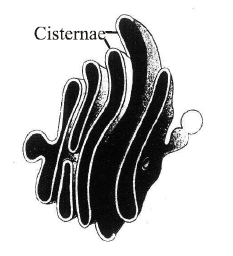
A. Rough endoplasmic reticulum
B. Smooth endoplasmic reticulum
C. Golgi body
D. mitochondria
Answer : C

A. Rough endoplasmic reticulum
B. Smooth endoplasmic reticulum
C. Golgi body
D. mitochondria
Answer : C
47. Which one of the following pairs is not correctly matched?
A. Cristae The tubular structure formed by the folding of the inner membrane of the mitochondrion.
B. Plasmodesmata The membrane surrounding the vacuole in plants.
C. Grana Membrane bound discs in chloroplasts that contain chlorophylls and carotenoids.
D. Middle lamella Layer between adjacent cells walls in plants derived from cell plate.
Answer: B
A. Cristae The tubular structure formed by the folding of the inner membrane of the mitochondrion.
B. Plasmodesmata The membrane surrounding the vacuole in plants.
C. Grana Membrane bound discs in chloroplasts that contain chlorophylls and carotenoids.
D. Middle lamella Layer between adjacent cells walls in plants derived from cell plate.
Answer: B
48. According to widely accepted fluid mosaic model cell membranes are semi-fluid, where lipids and integral proteins can diffuse randomly. In recent years, this model has been modified in several respects. In this regard, which of the following statements is incorrect?
A. Proteins in cell membranes can travel within the lipid bilayer.
B. Proteins can also undergo flip-flop movements in the lipid bilayer.
C. Proteins can remain confined within certain domains of the membrane.
D. Many proteins remain completely embedded within the lipid bilayer.
Answer : B
A. Proteins in cell membranes can travel within the lipid bilayer.
B. Proteins can also undergo flip-flop movements in the lipid bilayer.
C. Proteins can remain confined within certain domains of the membrane.
D. Many proteins remain completely embedded within the lipid bilayer.
Answer : B
49. The figure below shows the structure of a mitochondrion with its four parts labelled (A), (B), (C) and (D).

Select the part correctly matched with its function.
A. Part (D): Outer membrane Gives rise to inner membrane by splitting.
B. Part (B): Inner membrane Forms infoldings called cristae.
C. Part (C): Cristae Possess single circular DNA molecule and ribosomes.
D. Part (A): Matrix Major site for respiratory chain enzymes.
Answer : B

Select the part correctly matched with its function.
A. Part (D): Outer membrane Gives rise to inner membrane by splitting.
B. Part (B): Inner membrane Forms infoldings called cristae.
C. Part (C): Cristae Possess single circular DNA molecule and ribosomes.
D. Part (A): Matrix Major site for respiratory chain enzymes.
Answer : B
50. Which one of the following organelle given below is correctly matched with its function ?
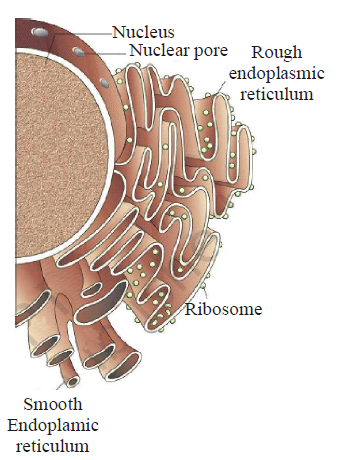
A. Golgi apparatus Protein synthesis
B. Golgi apparatus Formation of glycolipids
C. Rough endoplasmic reticulum Protein synthesis
D. Rough endoplasmic reticulum Formation of glycoproteins
Answer : C

A. Golgi apparatus Protein synthesis
B. Golgi apparatus Formation of glycolipids
C. Rough endoplasmic reticulum Protein synthesis
D. Rough endoplasmic reticulum Formation of glycoproteins
Answer : C
Sharing is caring
Related Post
1000+ Chemical Process MCQ for SSC CGL [Solved]
1000+ Word Power Multiple Choice Question Answer [Solved]
SSC JE - English Grammer 1000+ MCQ [Solved] PDF Download
CTET - Heat & Mass Transfer 1000+ MCQ [Solved] PDF Download
1000+ Php Programming MCQ for LIC ADO [Solved]
1000+ Current Affairs November 2022 Multiple Choice Question Answer [Solved]